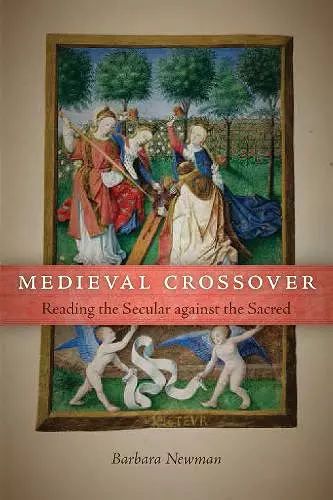Medieval Crossover
Reading the Secular against the Sacred
Format:Paperback
Publisher:University of Notre Dame Press
Published:15th May '13
Should be back in stock very soon

The sacred and the secular in medieval literature have too often been perceived as opposites, or else relegated to separate but unequal spheres. In Medieval Crossover: Reading the Secular against the Sacred, Barbara Newman offers a new approach to the many ways that sacred and secular interact in medieval literature, arguing that (in contrast to our own cultural situation) the sacred was the normative, unmarked default category against which the secular always had to define itself and establish its niche. Newman refers to this dialectical relationship as "crossover"—which is not a genre in itself, but a mode of interaction, an openness to the meeting or even merger of sacred and secular in a wide variety of forms. Newman sketches a few of the principles that shape their interaction: the hermeneutics of "both/and," the principle of double judgment, the confluence of pagan material and Christian meaning in Arthurian romance, the rule of convergent idealism in hagiographic romance, and the double-edged sword in parody.
Medieval Crossover explores a wealth of case studies in French, English, and Latin texts that concentrate on instances of paradox, collision, and convergence. Newman convincingly and with great clarity demonstrates the widespread applicability of the crossover concept as an analytical tool, examining some very disparate works. These include French and English romances about Lancelot and the Grail; the mystical writing of Marguerite Porete (placed in the context of lay spirituality, lyric traditions, and the Romance of the Rose); multiple examples of parody (sexually obscene, shockingly anti-Semitic, or cleverly litigious); and René of Anjou's two allegorical dream visions. Some of these texts are scarcely known to medievalists; others are rarely studied together. Newman's originality in her choice of these primary works will inspire new questions and set in motion new fields of exploration for medievalists working in a large variety of disciplines, including literature, religious studies, history, and cultural studies.
"Prolific medievalist Newman argues that though the sacred was the default perspective in medieval thinking, the sacred did not exclude the secular: there was ample creative room to blend the two perspectives. . . . A textual study at its best, Newman's work attempts to set the field back on track after years of debate over how to read a medieval text and whether medieval writers used the holy texts literally or could deploy them creatively at times." —Library Journal
“Newman’s book works against the effects of Robertson’s totalizing program, and on that score alone its contribution is considerable. . . Newman thus reveals a strain in medieval literary history with long antecedents and wide application. It would seem to have been waiting a long time to be revealed. On this view, then, Newman’s book is revelatory.” —Comparative Literature Studies
“Beyond the field of late medieval literary studies, Medieval Crossover is a must-read for scholars in any discipline concerned with secularization and passage to modernity. Medieval Crossover is the most powerful book about the interaction of pre-modern sacred and secular literary cultures since D.W. Robertson’s A Preface to Chaucer.” —Modern Philology
“In the conclusion, Newman generously identifies her work as laying a path to be pursued by others. In addition to the method it outlines, Medieval Crossover provides the ground for exploring why so many medieval texts and genres—in serious and playful registers—construct an inextricable relationship between the secular and the sacred, even when they seem most antithetical to one another.” —Studies in the Age of Chaucer
“Understanding these texts in conversation as crossover works, as Newman does, enriches and complicates our reading of each. . . . This book will be essential reading for any student of religion, history, or literary studies and will doubtless inspire much scholarship to come.” —Comitatus: A Journal of Medieval and Renaissance Studies
“The undeclared subject of this book is nothing less amazing or mysterious than the procreation of life through art. From the altitude of a medium-earth-orbit satellite, Newman’s ‘meandering path’ and its side-tracks describe an intricate pattern, crisscrossing and double-crossing, as elaborate as the swiveling of Love. . . . Thanks to Newman’s game-changing encore to the Donaldson/Robertson debate, we now can see a way to speak of crossovers between secular and sacred as tools of indigenation, and of indigenation as a protean driver in the evolution of social values.” —The Medieval Review
“Although Newman acknowledges her debt to other critics who have drawn attention to the use of paradox—the both/and—in the Middle Ages, her work itself is a strong contribution to this field of study. Instead of examining only the presence of sacred and secular, her work illustrates the different ways that the sacred and secular are integrated and does so in a text that is easily accessible to the reader.” —Sixteenth Century Journal
“The strengths of Medieval Crossover are manifold. . . . This is essential reading for students of history, religion, literature, and cultural studies, with sensitive English translations catering to readers who lack proficiency in Latin or Medieval French. Like those medieval texts that open themselves up to ‘double judgment,’ Medieval Crossover is guaranteed to provoke further debate and delight.” —French Studies
“This important book should be read by anyone with a serious interest in medieval English and French literature, the Bible and literature, the history of medieval theology (Latin and vernacular), and the vital and complex manifestations of sacred and secular motifs in Western thought.” —Renaissance Quarterly
"Barbara Newman, in her (as usual) fine study of medieval literature, takes on the debate of the past three decades around 'exegetics' or 'Robertsonianism,' offering a new approach to the sacred and secular in medieval literature. . . . Newman's concise yet readable narrative makes this accessible to non-specialists. Students of medieval literature, literary criticism, and hermeneutics will appreciate Newman's keen insights." —Magistra
ISBN: 9780268036119
Dimensions: 229mm x 152mm x 22mm
Weight: 558g
416 pages